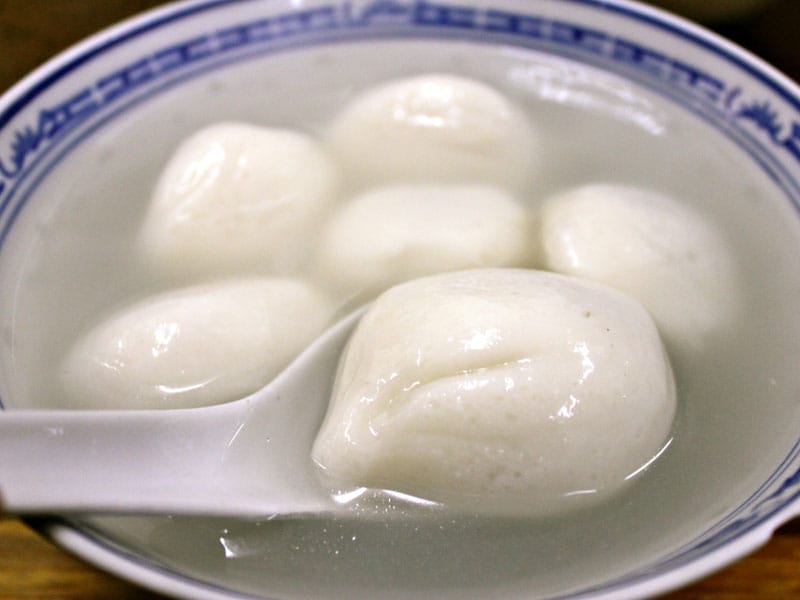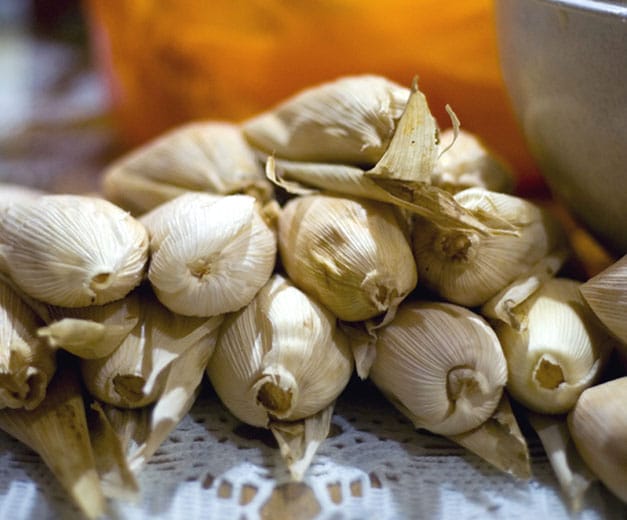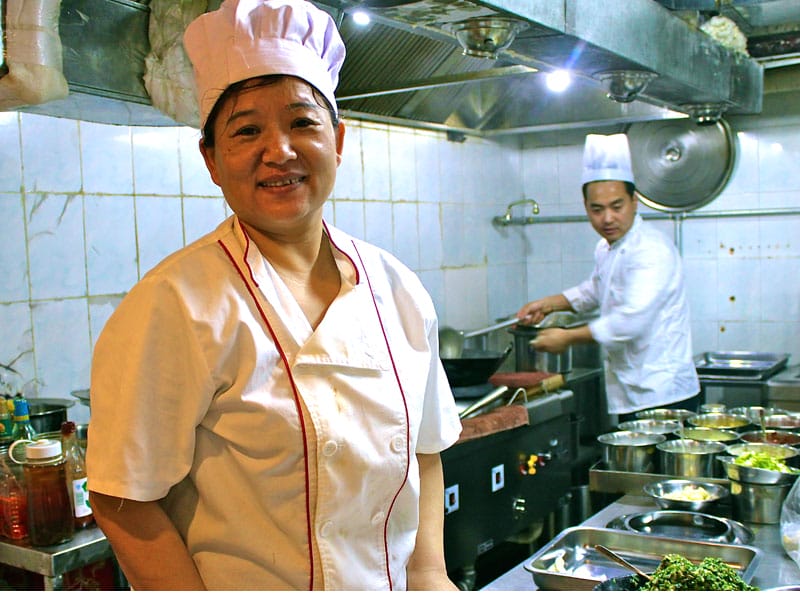Lantern Festival (元宵, yuánxiāo, or “first night”) is the fifteenth day of the Chinese New Year, and marks the last day of Spring Festival. This “first night” is actually the first full moon of the lunar new year, and in the Year of the Snake it lands on February 24. On this holiday, it’s customary for revelers to light red lanterns and eat sweet stuffed dumplings called tāngyuán (汤圆).
Tangyuan – also known as yuánxiāo, after the holiday on which they are eaten – are often referred to in English as glutinous rice balls because their main ingredient is flour made from “glutinous” or “sticky” rice. Traditionally, the balls come stuffed with sweet black sesame paste, although the fillings can vary; the Shanghainese, for example, also like to put a savory spin on the dumplings by making a version with pork.
Legends about the origin of Lantern Festival abound – from mythical cranes descending from the heavens to vengeful gods with herds of fire-breathing dragons – but one story rings truest to our hungry ears, and it is conveniently the one that explains how tangyuan came to be part of the myth. During the Han Dynasty (206 B.C. – A.D. 220), a girl named Yuan Xiao was taken from her home when she was very young to serve the emperor by making the best tangyuan in the kingdom. She hadn’t seen her family during all her years of servitude, and her homesickness had driven her to thoughts of suicide when one of the emperor’s advisors, Dong Fangshuo, found her weeping next to a well, contemplating her final leap. The kind mandarin heard her story and swore he would find a way to reunite her with her family.
To make good on his promise, Dong Fangshuo took over the street stall of a soothsayer and began foretelling that the God of Fire would send an inferno to burn down the capital on the fifteenth day of the first lunar month. The citizens of the capital panicked, and soon the emperor heard tell of the coming catastrophe, so he sent for his trusted advisor: Dong Fangshuo. The faux fortune-teller told the emperor that if the city were to set off fireworks and hang red lanterns on the fifteenth day of the month, it would look aflame and thereby appease the God of Fire. He also mentioned that the god’s favorite snack was glutinous rice balls, and that an offering of Yuan Xiao’s tangyuan wouldn’t hurt, either. The emperor agreed and invited his kingdom to take part in the celebration. Yuan Xiao’s family came to the capital to join in the festivities, where they were reunited with their daughter. And they all lived happily ever after.
Today, the perfectly round rice balls, and the bowls in which they are served, represent not only the family unity that brought together Yuan Xiao and her parents, but also the full moon that shines overhead during the holiday. Not only that, the word “tangyuan” sounds like the word for reunion, tuányuán (团圆) – a sweet note on which to end a holiday that’s all about family togetherness in China.
Below are two of our favorite places to try tangyuan in Shanghai. (Though tangyuan are most popular during Lantern Festival, they can be found at these venues year-round.)
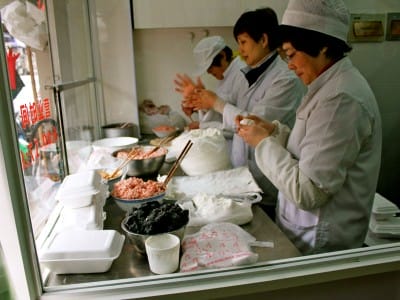 Shengxing Dim Sum
Shengxing Dim Sum
With more than 100 years of history under its belt, Shengxing clocks in as one of Shanghai’s oldest quick-serve restaurants. A glass window showcases three aunties ceaselessly folding wontons and tangyuan, while diners huddle around the three round tables, waiting for their chance to grab a seat and try the offerings. During winter, a heavy blanket hanging in front of the door is the only insulation from the chilly weather, but everything is served piping hot in soups that warm up diners from the inside out. Along with the wontons, the Shanghai-style pork-stuffed rice balls (鲜肉汤团, xiānròu tāngtuán) are the specialty here, but be careful when biting into these opalescent balls. The size of a baby’s fist, they are stuffed with juicy pork, and the dough made from glutinous rice flour proves to be an exceptionally effective insulator; no matter how long they sit in their soup, the juice inside is scalding. Small bites and slurping are the best way to get this done, but resist the urge to pop the whole thing in your mouth, no matter how good they taste. Also available are the traditional rice balls stuffed with black sesame paste, which make for a perfect sweet dessert after noshing down on the pork variety.
Dian Shi Zhai
On the other end of the culinary spectrum is Dian Shi Zhai. Step across the threshold at this restaurant and you’ll feel like you’ve been transported into a family home during Shanghai’s roaring ’30s. The former living rooms and parlors of this “old Western-style house” (老洋房, lǎoyángfáng) are filled with strategically placed tables, while bedrooms with 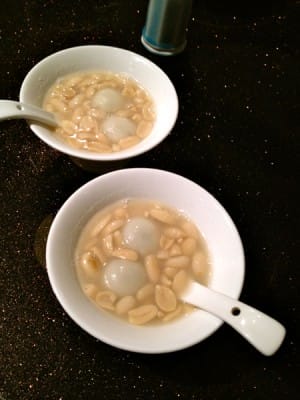 faded wallpaper have been turned into makeshift private rooms for more privileged meals. The menu is upper-class Shanghainese with local specialties such as red-braised pork (红烧肉, hóngshāoròu) and flash-fried shrimp (油爆虾, yóubàoxiā), but the real draw is the authentic range of tangyuan options for dessert. Peanuts are a symbol of longevity in China, and Dian Shi Zhai’s peanut-paste-stuffed rice balls, which float like pearls amongst boiled peanuts (花生圆子汤, huāshēngyuánzitāng) in soup broth, are simply unforgettable. Also don’t miss the sticky rice balls stuffed with sesame paste floating with grains of rice in a deliciously sweet rice wine soup ( 酒酿圆子, jiǔniàng).
faded wallpaper have been turned into makeshift private rooms for more privileged meals. The menu is upper-class Shanghainese with local specialties such as red-braised pork (红烧肉, hóngshāoròu) and flash-fried shrimp (油爆虾, yóubàoxiā), but the real draw is the authentic range of tangyuan options for dessert. Peanuts are a symbol of longevity in China, and Dian Shi Zhai’s peanut-paste-stuffed rice balls, which float like pearls amongst boiled peanuts (花生圆子汤, huāshēngyuánzitāng) in soup broth, are simply unforgettable. Also don’t miss the sticky rice balls stuffed with sesame paste floating with grains of rice in a deliciously sweet rice wine soup ( 酒酿圆子, jiǔniàng).
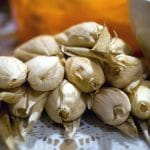 February 2, 2015 Tamales
February 2, 2015 Tamales
As we mentioned in our piece about Rosca de Reyes, February 2 is an important date in […] Posted in Mexico City October 3, 2016 Cuttlefish Grilled Dockside in Lisbon
October 3, 2016 Cuttlefish Grilled Dockside in Lisbon
Sardine season is a wild ride in Lisbon and it is finally coming to a close but we still […] Posted in Lisbon June 12, 2013 Lu Dajie
June 12, 2013 Lu Dajie
It’s not every day that you find a former national volleyball champ in the kitchen, but […] Posted in Shanghai
Published on February 22, 2013
Related stories
February 2, 2015
Mexico CityAs we mentioned in our piece about Rosca de Reyes, February 2 is an important date in the Mexican calendar - for Candlemas and, relatedly, for tamales. True, tamales are one of the most popular foods in Mexico City, and we can find all kinds of reasons for eating them any day of the week.…
October 3, 2016
LisbonSardine season is a wild ride in Lisbon and it is finally coming to a close but we still have the cuttlefish, grilled in ink, at the dockside classic on our "Song of Sea" culinary walk in Lisbon.
June 12, 2013
ShanghaiIt’s not every day that you find a former national volleyball champ in the kitchen, but that’s just the case with Lu Dajie (aka “Big Sister” Lu) and her eponymous restaurants. After a successful career with the Chinese military’s volleyball team, followed by years working in restaurants for others, she left her hometown of Jianyang…







































